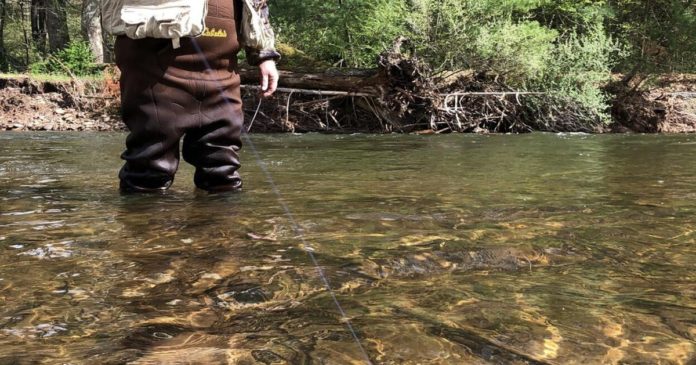While fly fishing can be a very rewarding pastime, there’s a bit of a learning curve when it comes to getting that fly neatly to the water.
One of the biggest hurdles to successful fly fishing is failing to properly understand how to cast. So many times, novice fly anglers can be seen slapping the water with excessive line, or worse yet, snapping their leader on a false back cast that extends well into the bushes.
Don’t worry, as all have been there, but thanks to a host of experienced anglers who patiently show the ropes through the years, competently presenting a fly on most occasions is learned. There’s hope for you too if you follow these important tips.
Thumbs up: A good cast begins with a good grip. Since casting a fly rod relies on the weight of the fly line being transferred back and forth, it is important to maintain control of this momentum with an appropriate grip.
Hold the rod above the reel with your thumb extended vertically along the back of the handle. Lock your wrist and try to avoid letting your hand flop loosely from your forearm. Try to maintain a steady grip, keeping your thumb up and perfectly in line with the rest of your forearm. Pivot from your elbow without rolling your wrist.
10 and 2: While observing the late great Lefty Kreh do what he did best (teaching a fly casting seminar), he repeatedly stressed the importance of remembering the “10 and 2 rule.” To feed and cast line, an angler must repeatedly transfer the load, meaning the weight of the line, in a back and forth motion. If you think of an analog clock, with 12 being straight at the top, you want the angle of your forearm, and thus also your thumb, to rotate back and forth between where 10 and two would lie on that same clock.
Again, keep your wrist locked but rotate from your elbow, back and forth between the two o’clock and 10 o’clock marks. Your rod tip should follow your thumb tip and forearm as the line flows forward and backward trailing the rod tip.
Take out some slack from the reel and feed more line as needed. Pausing the motion of your arm at these two angle points should cause the load of the line to continue on in the direction your rod tip just moved. Be careful not to overfeed and kill the momentum.
Feel the pressure: When following the “10 and 2 rule,” it is important to feel the full back pressure and front pressure of the load before continuing on in the opposite direction. As you false cast backward, halting your arm at the appropriate angle, pause momentarily until you feel pressure indicating the line is fully extended.
Then apply a bit of thumb pressure and move your arm forward to the appropriate angle, again halting abruptly and pausing until you feel the full pressure of the line before rotating backward.
Aim and shoot: Upon feeding out the desired amount of line, you’ll want to prepare for your final pitch by positioning the angle of your false back cast directly opposite of where you’d like your fly to land. This may require a slight pivot in your feet to line up, and a check to ensure your casting window is clear.
You’ll again want to load just like you did before, only this time, acquire your target as if it had a hula hoop around it, aim, point and shoot forward, (without flopping your thumb or wrist). Stop at your normal mark, let the loaded line fully extend forward, keeping it just high enough as to not slap the water, and when it reaches its full extension, allow the fly to gently dance down to the water.
Mend the line: The final thing to keep in mind after the cast is to present the fly in a drag-free drift. Keep your rod hand high as to prevent excess line from hitting the water. If the line does sit on the water, it will have a tendency to pull the fly faster or slower than the seam it’s in based on surrounding currents. To combat this, gently lift the fly-line off the water and flip it upstream without disturbing the leader or fly.
Fly casting takes practice, but you’ll get the hang of it the more you do it. Try to apply the basics, feel the pressure, and keep that wrist locked. Remember — thumbs up, and you’ll be on your way to better casting.
Credit: Source link































